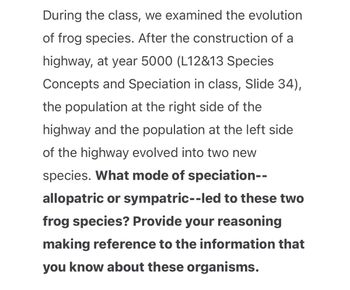
Human Anatomy & Physiology (11th Edition)
11th Edition
ISBN: 9780134580999
Author: Elaine N. Marieb, Katja N. Hoehn
Publisher: PEARSON
expand_more
expand_more
format_list_bulleted
Concept explainers
Question

Transcribed Image Text:During the class, we examined the evolution
of frog species. After the construction of a
highway, at year 5000 (L12&13 Species
Concepts and Speciation in class, Slide 34),
the population at the right side of the
highway and the population at the left side
of the highway evolved into two new
species. What mode of speciation--
allopatric or sympatric-- led to these two
frog species? Provide your reasoning
making reference to the information that
you know about these organisms.
Expert Solution
This question has been solved!
Explore an expertly crafted, step-by-step solution for a thorough understanding of key concepts.
Step by stepSolved in 3 steps

Knowledge Booster
Learn more about
Need a deep-dive on the concept behind this application? Look no further. Learn more about this topic, biology and related others by exploring similar questions and additional content below.Similar questions
- Jean-Baptiste de Lamarck’s model for large-scale evolutionary change involved primarily: dynamic, monophyletic speciation by cladogenesis static, polyphyletic speciation by cladogenesis dynamic, polyphyletic speciation by anagenesis static, monophyletic speciation by anagenesis static, monophyletic speciation by cladogenesisarrow_forwardWhich of the following statements is false? a. Gradual speciation is most likely to occur in a large population that lives in a stable climate. b. Punctuated equilibrium is unlikely to occur in a large population that lives in a stable climate. c. Gradual speciation and punctuated equilibrium both result in the divergence of species. d. Gradual speciation is most likely to occur in a small population that experiences a rapid change in its environment.arrow_forwardGiven your knowledge of how species evolve, why is it not likely that speciation will occur in the majority of species on the planet as a result of climate change?arrow_forward
- In which of the situations below would speciation be most likely to occur? You can choose more than one answer. a. Seven lemurs escape from an enclosure at Duke University. To everyone's surprise, they establish a small but viable population coexisting successfully with humans in a partly suburban environment very different from their native Madagascan habitat. b. Bighorn sheep occupy mountains from Canada to Death Valley in Southern California, interbreeding all along the way. The populations at the two ends of the range live in very different environments. c. A few individuals of a butterfly species were blown to an island during a severe storm. d. A population of juniper shrubs is split by the formation of a canyon. Every year, strong winds carry a small amount of the shrubs' pollen across the canyon.arrow_forwardTopic: Galapagos Finches Darwin’s readings took him to a predictive theory of how species might change with time: what later thinkers have called microevolution. Darwin’s philosophical worldview then took him beyond his evidence to a conviction that environmental constraints could create whole new structures and organisms. Soon Darwin’s theory of macroevolution replaced the Creator with an environment that could create solely by constraint. For your thread: According to Chapter 13 section 13.1, define microevolution and macroevolution. The Galapagos islands have a great diversity of landscapes – from lush vegetation to nearly barren lava fields yet the Galapagos Finches survive on each island. How can this be explained? Using the varying bills of the Galapagos Finches in figure 13.3 and additional research, explain how microevolution is evidenced.arrow_forward
arrow_back_ios
arrow_forward_ios
Recommended textbooks for you
 Human Anatomy & Physiology (11th Edition)BiologyISBN:9780134580999Author:Elaine N. Marieb, Katja N. HoehnPublisher:PEARSON
Human Anatomy & Physiology (11th Edition)BiologyISBN:9780134580999Author:Elaine N. Marieb, Katja N. HoehnPublisher:PEARSON Biology 2eBiologyISBN:9781947172517Author:Matthew Douglas, Jung Choi, Mary Ann ClarkPublisher:OpenStax
Biology 2eBiologyISBN:9781947172517Author:Matthew Douglas, Jung Choi, Mary Ann ClarkPublisher:OpenStax Anatomy & PhysiologyBiologyISBN:9781259398629Author:McKinley, Michael P., O'loughlin, Valerie Dean, Bidle, Theresa StouterPublisher:Mcgraw Hill Education,
Anatomy & PhysiologyBiologyISBN:9781259398629Author:McKinley, Michael P., O'loughlin, Valerie Dean, Bidle, Theresa StouterPublisher:Mcgraw Hill Education, Molecular Biology of the Cell (Sixth Edition)BiologyISBN:9780815344322Author:Bruce Alberts, Alexander D. Johnson, Julian Lewis, David Morgan, Martin Raff, Keith Roberts, Peter WalterPublisher:W. W. Norton & Company
Molecular Biology of the Cell (Sixth Edition)BiologyISBN:9780815344322Author:Bruce Alberts, Alexander D. Johnson, Julian Lewis, David Morgan, Martin Raff, Keith Roberts, Peter WalterPublisher:W. W. Norton & Company Laboratory Manual For Human Anatomy & PhysiologyBiologyISBN:9781260159363Author:Martin, Terry R., Prentice-craver, CynthiaPublisher:McGraw-Hill Publishing Co.
Laboratory Manual For Human Anatomy & PhysiologyBiologyISBN:9781260159363Author:Martin, Terry R., Prentice-craver, CynthiaPublisher:McGraw-Hill Publishing Co. Inquiry Into Life (16th Edition)BiologyISBN:9781260231700Author:Sylvia S. Mader, Michael WindelspechtPublisher:McGraw Hill Education
Inquiry Into Life (16th Edition)BiologyISBN:9781260231700Author:Sylvia S. Mader, Michael WindelspechtPublisher:McGraw Hill Education

Human Anatomy & Physiology (11th Edition)
Biology
ISBN:9780134580999
Author:Elaine N. Marieb, Katja N. Hoehn
Publisher:PEARSON

Biology 2e
Biology
ISBN:9781947172517
Author:Matthew Douglas, Jung Choi, Mary Ann Clark
Publisher:OpenStax

Anatomy & Physiology
Biology
ISBN:9781259398629
Author:McKinley, Michael P., O'loughlin, Valerie Dean, Bidle, Theresa Stouter
Publisher:Mcgraw Hill Education,

Molecular Biology of the Cell (Sixth Edition)
Biology
ISBN:9780815344322
Author:Bruce Alberts, Alexander D. Johnson, Julian Lewis, David Morgan, Martin Raff, Keith Roberts, Peter Walter
Publisher:W. W. Norton & Company

Laboratory Manual For Human Anatomy & Physiology
Biology
ISBN:9781260159363
Author:Martin, Terry R., Prentice-craver, Cynthia
Publisher:McGraw-Hill Publishing Co.

Inquiry Into Life (16th Edition)
Biology
ISBN:9781260231700
Author:Sylvia S. Mader, Michael Windelspecht
Publisher:McGraw Hill Education